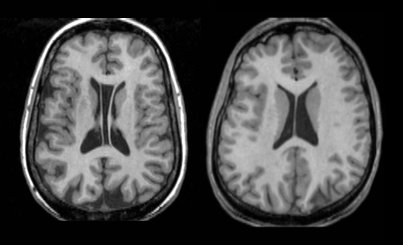Project Description
Schizophrenia is a complex disorder that is likely heterogeneous and involves both environmental and genetic influences. A promising approach to investigating genetic aspects of the disorder is to evaluate a group of patients with a defined genetic disorder. Individuals diagnosed with velocardiofacial syndrome (VCFS, also called 22q11.2 Deletion Syndrome) fit this description in that they have a high rate of psychiatric disorders, with up to 30% incidence of schizophrenia, and they evince a deletion on chromosome 22 (del22q11.2). Interestingly, several candidate genes for schizophrenia (COMT, PRODH, Tbx1, RTN4R) map into the region of this deletion. Variation in nucleotide sequence or absence of those genes is likely to predispose an individual to schizophrenia. We are collecting neuroimaging data from VCFS patients both with and without schizophrenia in order to determine whether or not variations in genes on chromosome 22 are altered in schizophrenia and whether there are concomitant changes in brain structure on MRI and diffusion tensor imaging scans.

Axial MRI scans from two VCFS subjects, the one on the left showing cavum septi pellucidi and the one on the right pronounced brain asymmetry.
Our first project in this area began in 2006 in collaboration with Dr. Raju Kucherlapati and Dr. Christine Finn, Harvard Partners Center for Genetics and Genomics, Harvard Medical School. Dr. Finn is now at Dartmouth Medical School. Neuroimaging findings to date show a high incidence of cavum septi pellucidi, brain atrophy and brain asymmetry in VCFS, changes that are also observed in schizophrenia. Dr. Zora Kikinis in our group performed a comparison of whole brain white matter of the 22q11DS group and a control group revealed major abnormalities in the left parietal deep white matter Kikinis et al. 2012. Performing tractography of the Inferior Longitudinal Fasciculus and Inferior Front-Occipital fasciculus, both long association fiber tracts conversing the parietal lobe, reconfirmed this finding Kikinis et al. 2013. We continue to explore brain white matter in young adult subjects with 22q11.2DS in a collaboration with Dr. Wendy Kates and Dr. Ioana Coman, SUNY, Syracuse, NY, who have collected diffusion weighted images for a longitudinal study on over 100 subjects to explore the biomarkers for psychosis. Abnormalities in specific white matter fiber tracts point to developmental changes in this population at high-risk to develop schizophrenia. While these data are preliminary, they are encouraging and suggest the utility of an analysis of a genetically defined subgroup of schizophrenia patients.






Comments are closed.